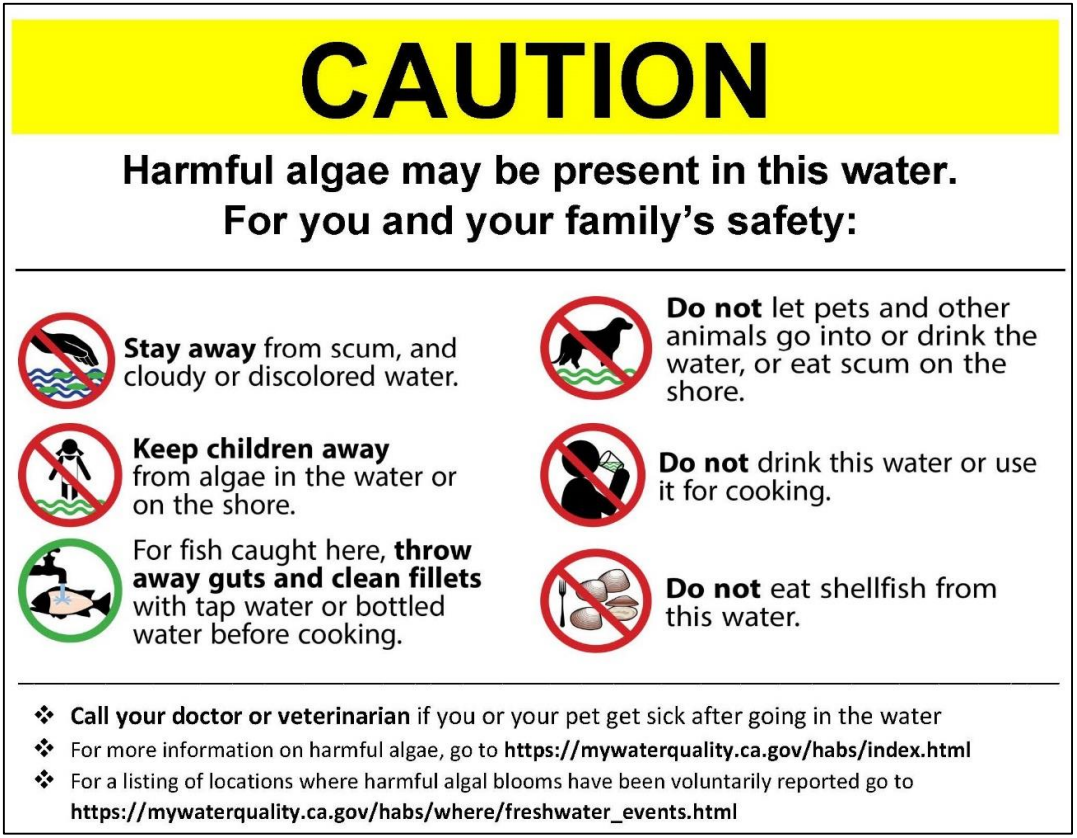STOCKTON, CA (August 6, 2019) – Warm temperatures are here and when conditions are right, blue-green algae can rapidly build-up or bloom on the surface of reservoirs, rivers, creeks, lagoons, lakes and ponds. Environmental Health and Public Health officials are urging swimmers, boaters, and recreational water users to avoid contact with blue-green algae (BGA), also known as cyanobacteria. The algae blooms may produce toxins that can present a health hazard to humans and animals. San Joaquin County Public Health Officer, Dr. Kismet Baldwin advises, “The best way to avoid illness is to exercise caution and observe signage that warns visitors to avoid active algal blooms.”
The algae blooms can look like green, blue-green, white, or brown foam and scum floating on the water. Children are especially vulnerable because they play on the shoreline, drink more water than adults when swimming, and are of a smaller body size. Dogs are especially vulnerable to BGA poisoning and many dogs are lost each year because they tend to drink more water and lick algae off their fur.
Human Exposure General Health Effects:
- Rashes or other skin irritations
- Allergy-like reactions, runny nose or sore throat
- Toxins ingested in large amounts can cause sharp, severe stomach problems like diarrhea and vomiting, liver damage, numb limbs, tingling fingers and toes or dizziness
Animal Exposure Health Effects:
- Weakness, staggering
- Difficulty breathing
- Convulsions
- Vomiting and diarrhea
- Death, if not treated
Statewide Guidance on Harmful Algae Blooms recommends the following:
- Avoid wading and swimming in water containing visible blooms or water containing algae scum or mats, which are most often present at the shoreline.
- Take care that pets and livestock do not drink the water or swim through scums, mats, nor lick their fur after going in the water. Wash exposed pets in clean drinking water.
- If no algae scums or mats are visible, you should carefully watch young children and warn them not to swallow the water. Do not drink, cook, or wash dishes with untreated water.
- Consume fish only after removing guts and liver, and rinsing fillets in clean drinking water. Mussels should not be consumed.
- Get medical treatment right away if you think you, your pet, or your livestock might have been poisoned by blue-green algae toxins.
Environmental Health Department staff will be posting Health Advisory signs at local marinas cautioning swimmers, boaters and recreational users to avoid contact with BGA.

The California Water Boards recommends that you practice Healthy Habits while enjoying the outdoors at your local lake, river, or stream. More information on healthy water habits can be found at https://mywaterquality.ca.gov/habs/do/
For more information, visit:
- California Harmful Algal Bloom Portal https://mywaterquality.ca.gov/habs/do/
- Report a potential harmful algal bloom at https://mywaterquality.ca.gov/habs/do/bloomreport.html
- California Water Quality Monitoring Council: https://mywaterquality.ca.gov/index.html
- California State Water Resources Control Board: https://www.waterboards.ca.gov/
- California Department of Public Health: https://www.cdph.ca.gov/Programs/CCDPHP/DEODC/EHIB/EAS/Pages/HABs.aspx
- CA Office of Environmental Health Hazard Assessment: https://oehha.ca.gov/ecotoxicology/generalinfo/information-microcystins
- U.S. Centers for Disease Control & Prevention: https://www.cdc.gov/habs/index.html
- U.S. Environmental Protection Agency: https://www.epa.gov/nutrientpollution/harmful-algal-blooms
# # #
-
County AdministratorSan Joaquin County Requests Nearly $27 million in Funding from Federal Lawmakers April 18, 2025
-
Board of Supervisors — District Attorney — Sheriff-Public AdministratorSan Joaquin County Board of Supervisors Approves New Cold Case Task Force April 14, 2025
-
Board of Supervisors — Health Care ServicesBoard of Supervisors Appoints Genevieve Valentine to Lead Health Care Services April 8, 2025